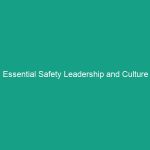Introduction
Good morning team,
Today, we are going to talk about a topic that is crucial for our overall health, productivity, and Safety: Essential Sleep Safety Guidelines: Avoid Common Risks for Better Rest. Sleep is often overlooked in the Workplace Safety discussion, but it plays a vital role in our performance and well-being. Lack of quality sleep can lead to serious Safety risks, not just for ourselves, but for our colleagues as well.
Understanding Essential Sleep Safety Guidelines
So, what are Essential Sleep Safety Guidelines? These are practices and recommendations aimed at ensuring we get the restorative sleep we need to function effectively at work and in our daily lives. Quality sleep is essential for cognitive functions, decision-making, and physical health. When we don’t prioritize sleep, we increase the risk of workplace accidents, decreased productivity, and long-term health issues.
Many people believe that they can function well on minimal sleep or that sleep is a luxury rather than a necessity. This misconception can lead to dangerous situations in the workplace, particularly in roles that require high levels of concentration and attention to detail.
Key Hazards, Risks, and Safety Considerations
Understanding the risks associated with poor sleep hygiene is essential. Here are some specific Hazards and risks:
- Increased Accident Risk: Sleep deprivation can impair judgment and reaction times, leading to accidents.
- Health Issues: Chronic sleep deprivation is linked to obesity, diabetes, cardiovascular disease, and impaired immune function.
- Decreased Productivity: Fatigue can lead to lower work efficiency and errors that can affect the entire team.
- Mental Health Problems: Lack of sleep is associated with anxiety, depression, and other mental health issues.
Ignoring these risks can have serious real-world consequences, including workplace injuries, long-term health problems, and a negative impact on team morale.
Best Practices, Procedures, & Actionable Advice
Now that we understand the risks, let’s talk about Best Practices to promote better sleep and safety:
1. Establish a Sleep Routine
Creating a consistent sleep schedule can help regulate your body’s internal clock. Aim to go to bed and wake up at the same time every day, even on weekends.
2. Create a Sleep-Friendly Environment
Your bedroom should be conducive to sleep. Keep it dark, quiet, and cool. Consider using blackout curtains, earplugs, or white noise machines to minimize disturbances.
3. Limit Screen Time Before Bed
Exposure to screens can interfere with your ability to fall asleep. Try to avoid screens for at least an hour before bedtime and consider reading a book or practicing relaxation techniques instead.
4. Be Mindful of Your Diet
Avoid heavy meals, caffeine, and alcohol close to bedtime. These can disrupt your sleep patterns and lead to poorer quality sleep.
5. Engage in Regular Physical Activity
Regular exercise can significantly enhance sleep quality. However, try to avoid vigorous workouts close to bedtime, as they may have the opposite effect.
6. Manage Stress and Anxiety
Implement relaxation techniques such as meditation, deep breathing exercises, or yoga to manage stress levels. A calm mind promotes better sleep quality.
7. Seek Professional Help When Needed
If you consistently struggle with sleep, it may be time to consult a healthcare professional. Sleep disorders can have serious health implications and require expert intervention.
Regulations, Standards, and Compliance
It’s vital to recognize that sleep safety is not just a personal issue but also a workplace concern. Various organizations, including OSHA, emphasize the importance of employee health and safety, which includes ensuring that employees are well-rested and alert. Compliance with these Standards is critical as it helps protect not only you but also your colleagues and the company as a whole.
Employee Engagement & Discussion
Now, let’s open the floor for discussion. What safety challenges have you encountered related to sleep? Have you noticed any impacts of fatigue on your work or the work of your colleagues? Sharing experiences can help all of us understand the importance of prioritizing sleep safety.
Conclusion & Key Takeaways
In summary, prioritizing sleep is crucial for maintaining a safe and productive workplace. By following these essential sleep safety guidelines, we can significantly reduce risks and enhance our overall well-being. Remember, a well-rested team is a productive team.
Thank you all for your attention and for your commitment to making our workplace a safe and healthy environment. Let’s make sleep safety a priority!


